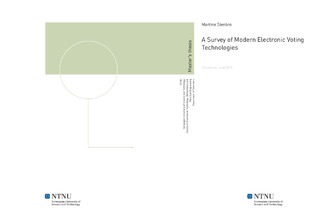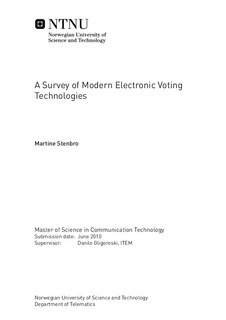| dc.description.abstract | The last decade, electronic voting has evolved from being a mean of counting votes to also offer the possibility of electronically casting votes. From recording votes using punch cards and optical scan systems, electronic voting has evolved into the use of direct-recording-electronic machines. Voting over the Internet has also become a hot research topic, and some implementation and testing have been done. Internet voting systems are significantly more vulnerable to threats from external attackers, than systems to cast ballots in controlled environments. Mechanisms to provide security, accuracy and verification are critical, and issues with coercion and usability also arise.In the first part of this thesis we give a theoretical study about existing electronic voting techniques, as well as requirements and security issues of modern electronic voting systems. We also give a brief background theory of some cryptographic mechanisms and systems. Secondly, we present two modern voting solutions in development. We have included security functionalities provided by the system, the cryptographic techniques used and some threats and attacks to the systems. These systems can be exposed to compromised computers, ballot stuffing, and corrupt infrastructure players, but are using cryptographic proofs to ensure accuracy and counter attacks.In the third part, we create a procedure and perform a usability test on one of these modern voting solutions. Our findings emphasize the fact that there is a tension between verifiable elections and usability. The voters have trust in the privacy and accuracy of such a voting systems if more guidance to utilize the means of verification is included, and a trusted third party verifies the system security. The advantages of electronic voting outweigh the risks. Internet voting is a term of further discussion and testing, but considering coercion and the insecure aspects of the medium, Internet voting will never be 100% safe. It is a question of trade off between the advantages and threats. | nb_NO |

